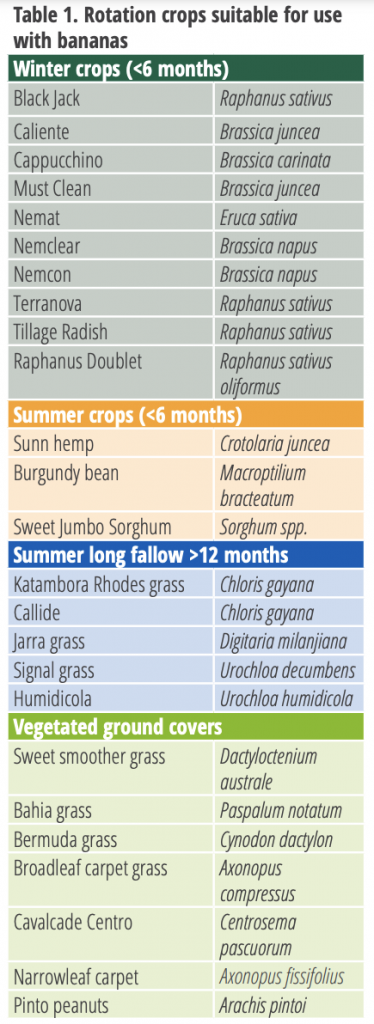By Tony Pattison, Department of Agriculture and Fisheries
Losses and damage caused by plant-parasitic nematodes, like burrowing nematode, are reoccurring problems on many banana farms.
The nematodes feed on the roots of the plants (Fig 1) and can slow plant growth, reduce bunch weights and in worst case scenarios cause plants to fallout (Fig 2).
This makes plant-parasitic nematodes a constant headache for banana growers. In the past, nematodes were managed by the application of chemical nematicides.
However, resistant rotation crops are another method for reducing nematode numbers. Resistant crops are those that do not support nematode feeding and/or breeding. This reduces the numbers in the soil, greatly increasing productivity in the following banana crop. Previous research identified different resistant rotation crops and varieties, giving banana growers options for their banana cropping systems.
While the rotation crops allowed a reduction on the reliance on chemical nematicides and helped to improve soil health, they didn’t work as well as desired on all farms.
Changes have occurred in rotation crops available to banana growers, with the loss of some varieties and new varieties becoming available.
Recent research by the DAF Nematology Team, as part of a Hort Innovation project has screened more than 30 potential crop rotation varieties for resistance to burrowing nematode. (Table 1) For a variety to be deemed as having good resistance it must reduce the burrowing nematode population by more than 95%, compared with bananas in glasshouse experiments. Resistant ground covers suitable for banana plantations are also listed in Table 1.

During the cooler “winter” months in north Queensland, members of the Brassica family are a good rotation crop option (Fig 3). These tend to be short lived crops of 2-3 months and are ideal for a 9-12-month fallow period. For fallows in warmer parts of the year, sunn hemp is proving to be a good fit with good resistance and high biomass production. For longer fallows greater than 12 months, Rhodes grass or signal grasses can be good options.
Crops grown for long term rotation with bananas tend to take more time to become established, but can improve soil structure and prevent erosion.
Banana growers have also been experimenting with blends, by purchasing seed mixes.
However, many of the commercially prepared blends tend to contain plants that can be nematode hosts. Having a nematode host plant can undo the crop rotation and fallow period, allowing nematodes to survive until the next banana crop. This can lead to nematode problems occurring early in the plantation cycles. Growers can make their own blends of compatible species provided that only resistant crops are used (Fig 4).
A well-managed crop rotation phase in the plantation cycle can mean that plant-parasitic nematodes are no longer the constant problem experienced on other farms. Rotation crops can also have other soil health benefits by increasing soil organic matter and creating greater biological diversity.
More information and a tool to help select nematode resistant crops can be found at Nematode resistant crop rotations – Lucid Web Player (lucidcentral.org)

